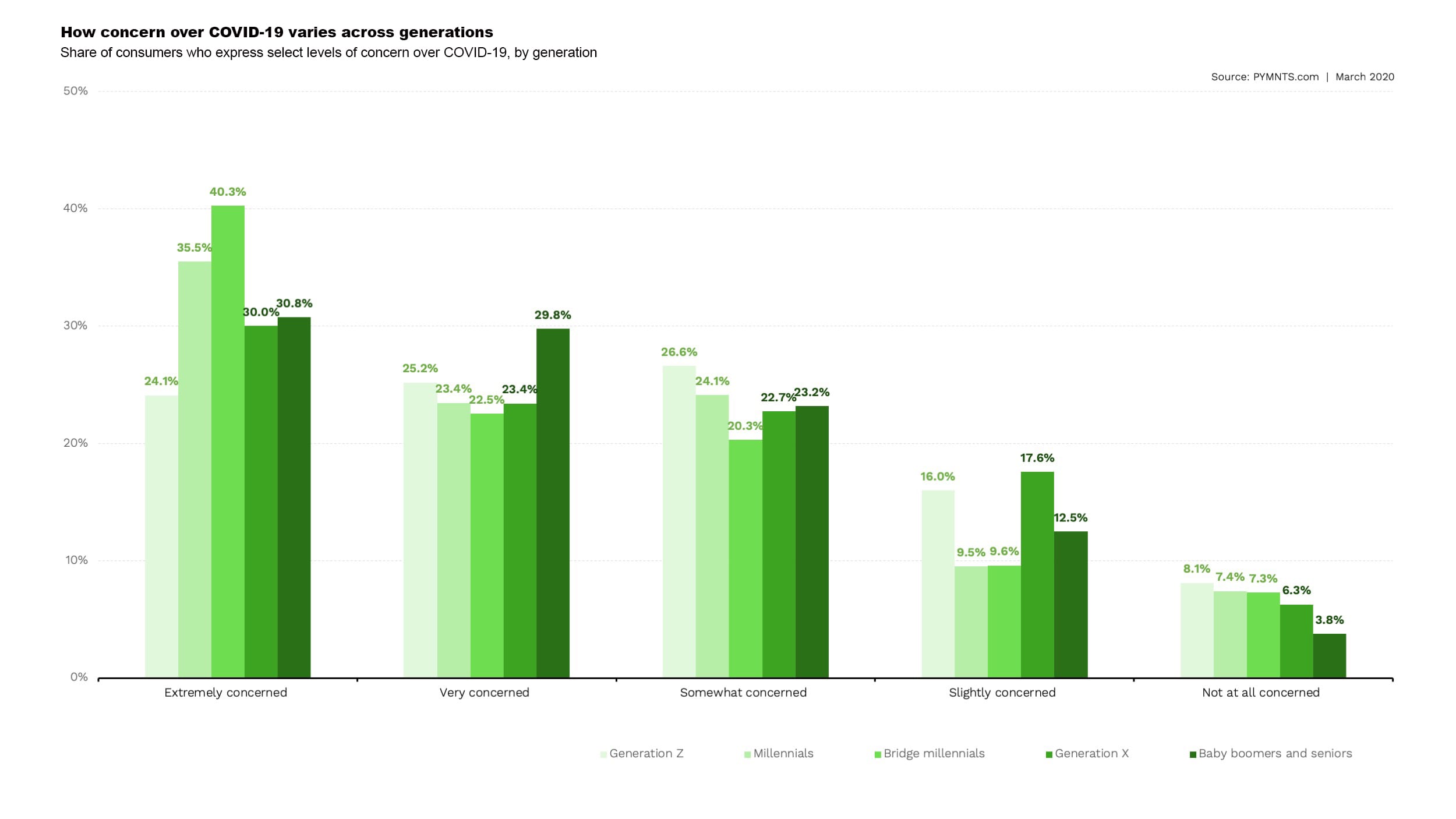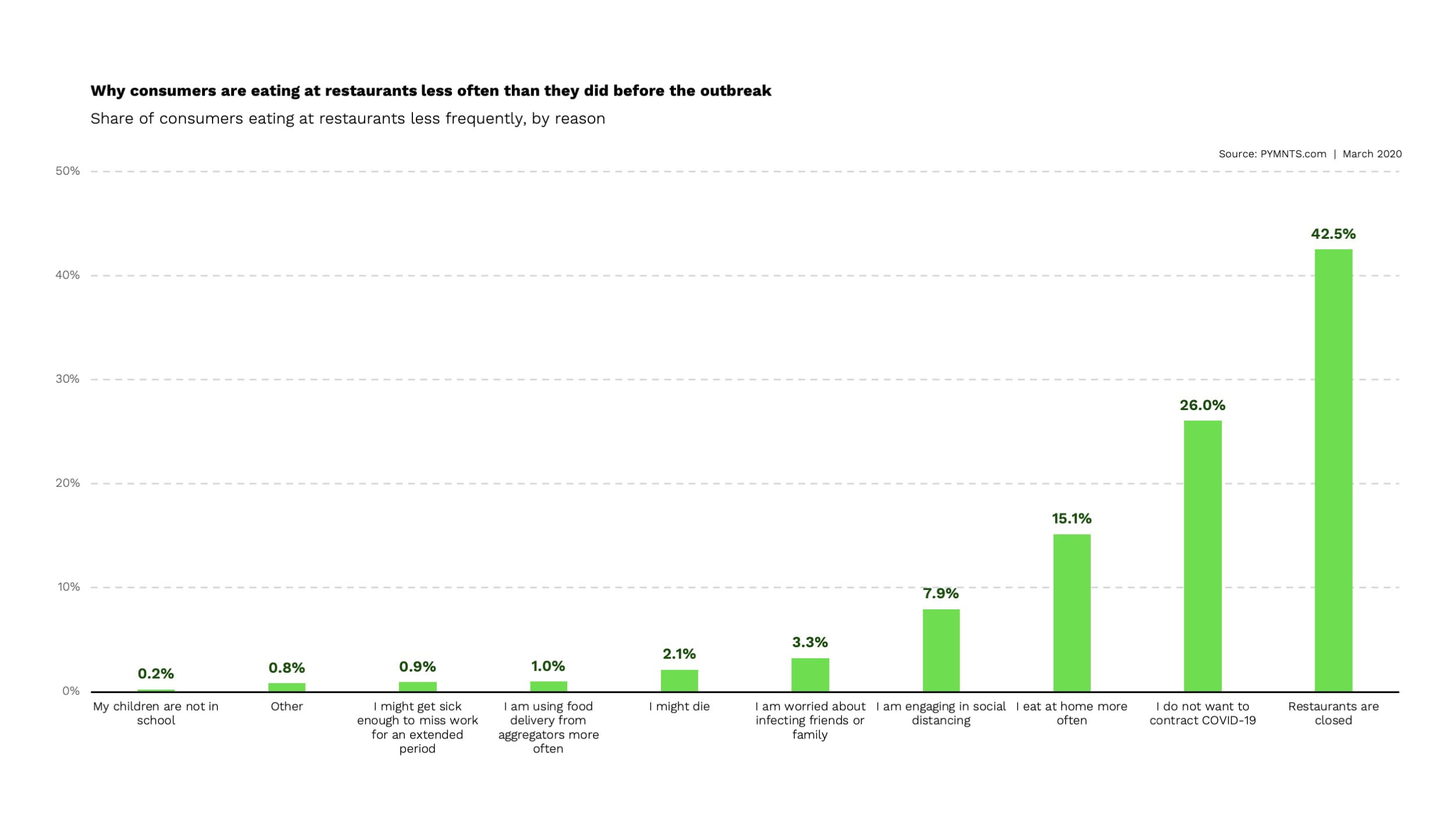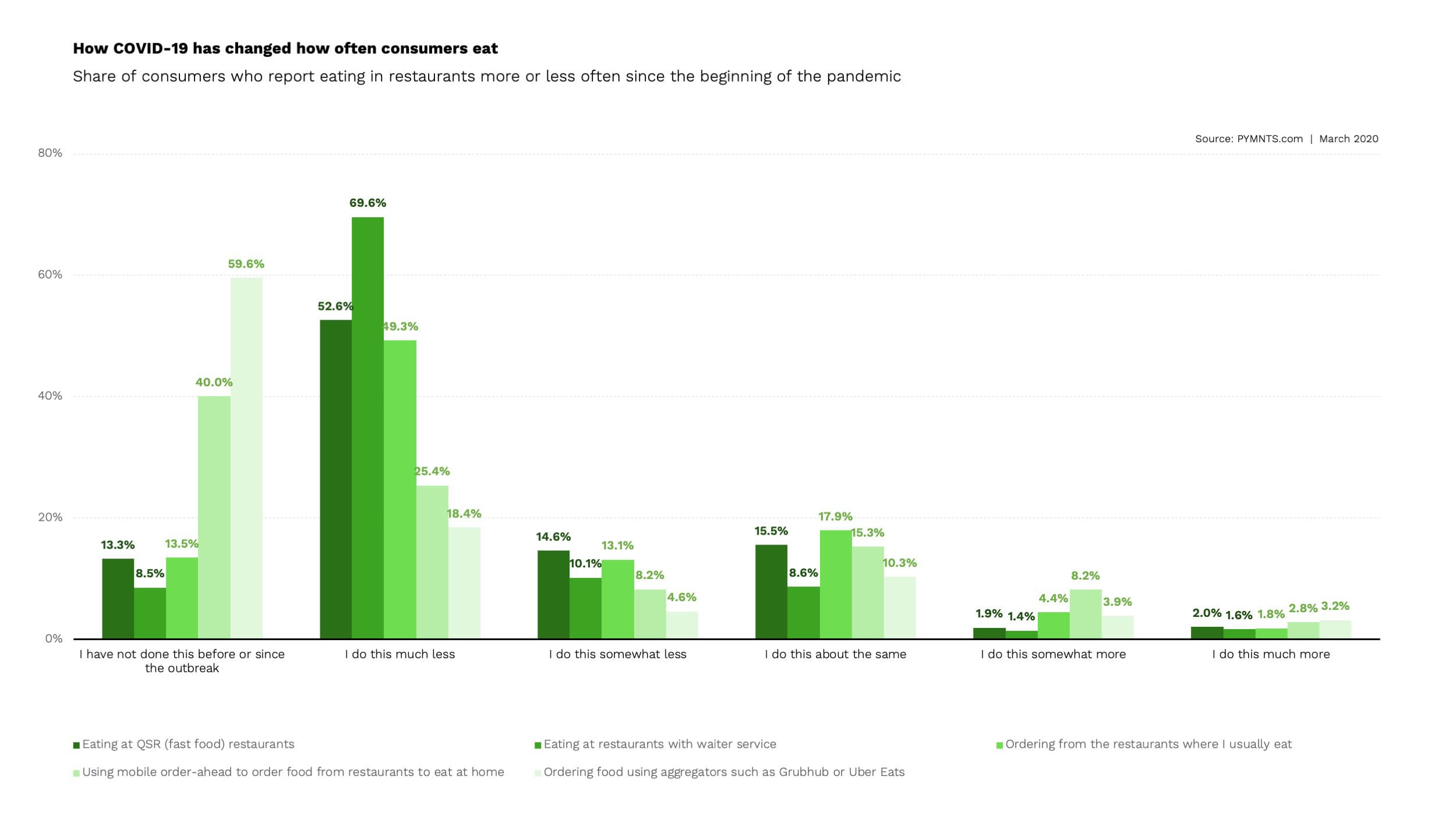Thursday, March 19 was the first day of spring in the U.S. — a season that is symbolic of rebirth and renewal after a long, cold winter.
It was also the day that we got our first look at the latest PYMNTS study of 1,923 representative U.S. consumers and the changes to their daily behaviors due to the COVID-19 pandemic.
We went back into the field on March 17 — only 11 days after our first study was launched on March 6 – to see what had changed since our first benchmark study. You’ll recall that the week of March 6 was when the coronavirus first became real for most people living in the U.S., with a large number of outbreaks reported in Kirkland, Washington.
On March 6, consumers could largely make their own decisions about what was in or out of bounds based on their personal level of concern overexposure to the virus. Stores, schools and businesses were still open. Even though consumers weren’t being forced to socially distance, they were already doing that in many ways. Our first study documented how changes in behavior redefined the consumer’s day-to-day activities — how they worked, shopped, traveled, ate, bought food and spent their leisure time.
What a difference 11 days makes.
By March 17, Johns Hopkins was reporting 3,200 confirmed cases of the COVID-19 virus in the U.S., with 65 deaths. Virtually all sporting events had been canceled or postponed, and theme parks were closed. The CDC had issued guidelines limiting gatherings to 50 or fewer participants.
San Francisco had just ordered citizens to self-quarantine. Airlines had cut routes due to lack of demand or governments closing their borders to travelers. Hotels reported sharp declines in occupancy. Cruise lines had stopped more cruises as they got distressed ships to port.
Retail stores were still open, but some local shops in certain cities had begun to curtail hours due to declining foot traffic. Some schools in certain counties had decided to close for a few days or a few weeks. Colleges were starting to tell spring breakers not to return for the rest of the semester.
The four days between March 12 and March 15 saw Americans empty grocery store shelves and binge-buy toilet paper and hand sanitizer. The entire country of Italy went on lockdown, and reports of confirmed cases and deaths had skyrocketed in the country. Dr. Anthony Fauci, director of the National Institute of Allergy and Infectious Diseases, went on Meet the Press on Sunday, March 15 and warned that America was on course to look more like Italy than China, and that millions of Americans were at risk of dying from the virus. He further advised the country to do “whatever was necessary” to flatten the curve, including closing restaurants and bars nationwide.
A day later, the governors of Ohio, Illinois and California announced the shuttering of bars and restaurant dining rooms, and New York City closed its schools.
Like just about everything associated with this global pandemic and its unprecedented impact on every aspect of our daily lives, context is critical. Not surprisingly, the results from our second, census-balanced study of the U.S. population portrayed a consumer in a very different place — and with anything but a spring in her step.
What A Difference 11 Days Makes
Between March 6 and March 16, the number of U.S. consumers who reported being extremely concerned about contracting COVID-19 doubled, with 32 percent of the population reporting that level of concern versus 20 percent 11 days earlier. We observed a sharp increase in the number of baby boomers and seniors who now say they are concerned, going from 33 percent on March 6 to 61 percent on March 17.
Not surprisingly, we saw that the level of concern spikes if someone in the consumer’s social network has presented symptoms, even though only 7.7 percent of the population reported knowing someone who has.
Our March 6 study reflected an over-indexing of COVID-19 concerns among those living in highly populated urban centers and large cities, with 54 percent of those living in urban centers expressing concern compared to 31 percent of those living in rural communities.
That wasn’t the case 11 days later.
Concern about contracting COVID-19 is now largely consistent regardless of where people live, across urban centers of one million or more people and rural towns of less than 25,000 people.
 By March 17, we saw that Americans’ biggest concern was transmitting the virus to family members or friends (72 percent), but they were also two and a half times more afraid of dying from COVID-19 (42 percent) than losing their job (18 percent).
By March 17, we saw that Americans’ biggest concern was transmitting the virus to family members or friends (72 percent), but they were also two and a half times more afraid of dying from COVID-19 (42 percent) than losing their job (18 percent).
More than half (54 percent) of baby boomers in our sample say they are worried about dying from COVID-19, as are 46 percent of consumers earning less than $50,000 a year.
According to our sample, it’s also a population that ranks losing social contact as the third greatest risk of the COVID-19 outbreak (41 percent) above losing their financial wealth (30 percent), despite the unprecedented levels of stock market turbulence over those 11 days. At 57 percent, Gen Z is the generation most concerned with the social impact of COVID-19 on their daily lives, a sentiment that is the subject of great criticism and concern in the face of their very public “spring breakdown.”
In the span of 11 days, we observed an American consumer who came to believe that the media is portraying the COVID-19 risk accurately, an increase from 26 percent on March 6 to 36 percent on March 17 — but some still believe that the federal, state and local government’s portrayal of the risk is much worse than it really is.
Thirty-eight percent of our sample and 42 percent of the 32- to 41-year-old bridge millennials share that view.
 In 10 short days, we saw American consumers pulling back on consumption and changing their buying patterns radically across every single daily activity, largely over fears of contracting the virus.
In 10 short days, we saw American consumers pulling back on consumption and changing their buying patterns radically across every single daily activity, largely over fears of contracting the virus.
Nearly a third (31 percent) of consumers said they are working from home, and 46 percent and 47 percent have stopped traveling for business and leisure over fears of contracting the virus — not because their businesses were closed or because they were told to not hop on a plane.
Consumers who were already practicing social distancing and refraining from shopping in physical stores are keeping their distance even more — and that was shown to be true across all incomes and demographic groups. Nearly 78 percent of consumers in our March 6 study reported shopping in physical stores, an activity that was already down by 30 percent from their usual daily patterns.
By March 17, those numbers were 75 percent, a decline of 150 percent. Among those who reported being extremely concerned, those numbers are even more dramatic — at 84 percent on March 17, up from 57 percent on March 6.
And what are consumers buying? Just the essentials, ma’am — or what consumers now regard as essentials.
That’s cleaning supplies (24 percent increase), medical supplies (18 percent increase) and games (10 percent increase), as parents look to buy things to keep the kids busy while at home (and while trying to work from home right along with them).
Apparel and accessories, not so much — they were down 42 percent from before the COVID-19 crisis.
As one retail executive shrewdly noted last week: Who needs to buy clothes when people are self-quarantining?
The work-from-home trend over the last several years certainly changed the mix of clothes that consumers were buying — but they were still buying. Now, there are no walks to Starbucks, carpool runs, school plays, sports events, movie nights, dinners out, weekend trips with family and friends or vacations — which means there is no reason for anyone in the household to buy anything new.
The Restaurant Reality
We didn’t need nearly 2,000 U.S. consumers to tell us about the dire straits restaurants are in — particularly independent restaurants — as a result of the COVID-19 pandemic. Stories abound of restaurant after restaurant closing, laying off staff, and shifting from dine-in to takeout and delivery. Danny Meyer, restaurant icon and founder of Shake Shack, closed all of his 254 establishments and laid off 2,000 employees in the space of a week, in a sobering sign that the entire sector is on shaky ground.
 What’s also been reported is the pivot independent restaurants have made to order-ahead and takeout to generate any possible sales and keep some staff working.
What’s also been reported is the pivot independent restaurants have made to order-ahead and takeout to generate any possible sales and keep some staff working.
But it doesn’t appear that consumers are using those restaurants in that way.
Unlike other daily activities that involve being around people in a physical environment — travel, shopping, working, going to events — 43 percent of consumers in our sample reported that they stopped going to restaurants because they are closed. Only 26 percent of consumers reported not visiting restaurants over fears of contracting the virus.
Yet only 1 percent of consumers reported ordering takeout or delivery from those establishments.
For the consumers in our sample, we also observed a 7 percent decline in ordering from Grubhub or Uber Eats over the 11 days between March 6 and March 17, with the share of consumers using mobile order-ahead from restaurants decreasing by 11 percent.
 Millennials and bridge millennials are the two generations most likely to use both mobile order-ahead and aggregators less now than before the outbreak. We found that 44 percent of millennials and 40 percent of bridge millennials in our sample report are using mobile order-ahead somewhat or much less often than before the outbreak. We also saw that the share of millennials using aggregators has decreased by 36 percent, and the portion of bridge millennials using aggregators has dropped by 32 percent.
Millennials and bridge millennials are the two generations most likely to use both mobile order-ahead and aggregators less now than before the outbreak. We found that 44 percent of millennials and 40 percent of bridge millennials in our sample report are using mobile order-ahead somewhat or much less often than before the outbreak. We also saw that the share of millennials using aggregators has decreased by 36 percent, and the portion of bridge millennials using aggregators has dropped by 32 percent.
That decline could be the result of orders not being delivered to offices, consumers not using order-ahead for breakfast or lunch, or concerns about delivery aggregators handling their food.
But all consumers reported eating more at home and cooking the food they bought at grocery stores, whether by choice or necessity.
The picture for restaurants is sobering. A sector of establishments that was grabbing an increasing share of stomach as consumers gravitated to going out to eat with family and friends is now competing with grocery stores (again) for their very survival, across both digital and physical channels. Sixty-one percent of our survey respondents said they never shopped for groceries online and picked up curbside before the COVID-19 pandemic; now, 12 percent do it much more than ever before.
The same consumers who seem to be upping their online ordering and curbside pickup game don’t seem to be doing that with the restaurants they once visited every Friday or Saturday night.
The Future
We were also curious how long consumers in our study think it will take for their daily activities to resume to the level they were before the COVID-19 pandemic became a reality for them and this country.
Roughly a quarter (27 percent) of consumers believe it will be two weeks to a month, with roughly another quarter (25 percent) reporting that it would take two months. Boomers are the most pessimistic at a year or more, and bridge millennials are the most optimistic at two weeks.
That finding suggests that roughly half the country believes that by Memorial Day, COVID-19 will be in the rear view, under control enough for the venues that are now closed to reopen — and for life to pick up where it left off at the start of what most people will describe as the longest March they’ve ever experienced.
But that was back when most businesses said they’d be closed through the end of March, maybe until April 3. And back when the schools said they would close for a month. At that time, San Francisco residents were self-quarantining for three weeks, and gyms and exercise studios said, “see you on April 1.”
Consumers based their perspectives — and their responses to our survey — on what they had been told.
In just the last week, though, things have become even more restrictive, and the picture of when things will (sort of) get back to normal is much less clear.
What is becoming more clear is that the “normal” on the other side of COVID-19 will be redefined by two things:
First, how much of the consumer’s “new normal” sticks.
Businesses may decide that working from home is pretty efficient for more of their employees.
Even more consumers may decide that watching movies on the big screen in their living rooms beats going out to the movies — particularly since Hollywood is bypassing shuttered theaters and going straight to streaming sites for the first run of their movies.
Consumers could also decide that online yoga lessons and spinning in the privacy of their own homes on their Peloton bikes beats beating it to the gym.
Or that shopping online for groceries — or just about anything — is much more convenient than going to the store.
But a big part of that normal will be defined by what the business landscape looks like at that time, and whether the gyms, the restaurants and bars, the vacation rentals that were once annual family traditions, the hair salons, the shops and boutiques in their local communities — even the businesses they work for — will be there for consumers to revisit two weeks, two months, six months or a year from now.
That, unfortunately, is beginning to look far less likely.
Our next survey goes into the field in the middle of next week. We’ll see what the next 11 days brings.